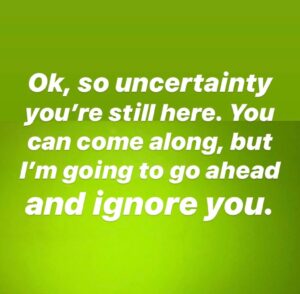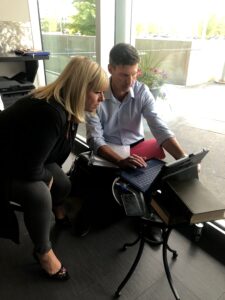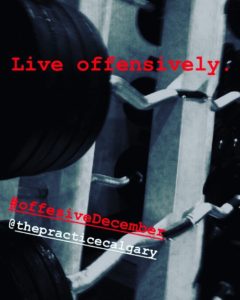We’ve been away from social media, more or less, for the last couple of months. This was on purpose. Christy and I have been working behind the scenes to realign, revision, and launch new initiatives for The Practice Calgary. That’s the official statement, and it is true. But the deeper truth is that I was taking a walk with uncertainty. It really does not matter how ‘successful’ a person has been, or capable they have felt or been perceived as, insecurity and uncertainty don’t care. It is Ok to acknowledge it.

I took a step back because I wasn’t entirely clear where I was at, and where we were going. I recognized it when I observed where my energy was going, and it seemed that somewhere along the line I began promoting instead of communicating. I was second guessing, and looking at the likes, instead of focusing on who we are and what our vision is. When I could see this, I allowed myself to ‘not know’ and reminded myself that there is no urgency. The timeline is false, as timelines generally are. In this period, I really focused on what I know to be true for me; working with clients, friends and family, meditation and reflection, running, and fun. Amazing things happen when you let go.

The clarity came when Christy and I returned to the original business plan. We could see what had been pushed aside, what no longer fit, and what we are doing very well. During the weeks of sitting with uncertainty, who had become like a rather annoying child as opposed to a frightening adversary, my clarity grew and with that came confidence. “Ok, so uncertainty, you’re still here. You can come along, but I’m going to go ahead and ignore you”. Finally, I could see our vision, mission, and goals. Together we could dream out loud again! Another thing happened during our retreat, at the exact moment that I felt the welling surge of insecurity rearing to a point of killing my plausible deniability, our business surged (amazing, thank you <3). Planned happenstance. This is what we have been waiting for; three wildly talented and experienced professionals joined our team (amazing story for another time). Christy and I have learned a great deal in the years we have fostered The Practice Calgary, most important we learned to lean our intuition. We have long-identified a need for experienced clinicians to grow our team, but countless interviews have ended up with us going with our gut “not the right fit”. So, in spite of my predicament, when the right people emerged, we felt it was the only move was to welcome new team members. Ever felt compelled forward, even though internally you are feeling more than a little lost? When exactly what you have been dreaming of manifests into reality you don’t exactly tell the Universe that you need a minute to collect yourself.

The vision for The Practice Calgary is to normalize emotional and mental health by being a team of real and approachable professionals. The vision is to truly be a safe and welcoming health and wellness home where the helpers are transparent and experienced, and where the guidance is real (no, you do not have to look in the mirror and Guy Smiley it). Mental health should be as acceptable as physical health. This means internally we must have people who want to be there, who are happy to be there, who live well and hold a genuine place of non-judgement. If we are not supporting each other, then we have no business supporting you. Socially responsible. That is an absolute actionable goal and this is what, in hindsight, caused my Instagram energy to morph into a brick wall in perfect time for me to hit it. To me socially responsible means honest. Social media can be great, but it can do a lot of damage by skewing our perception of life. Honest, real, and thought provoking. Never for ‘likes’ and never staged. The intention is as important as the action.

So, thank-you uncertainty for causing us to hit pause. Thank you to an amazing team and community that allowed us to sit quietly. Now we feel energized and excited to continue making mental health real and relatable, break down barriers to getting support, and to have a lot of fun while we do it! We’d love for you to keep in touch with us. We’ll be introducing our team, letting you know about community engagement evenings (starting with a no-cost Evening with Dr. Liann Meloff, R Psyc on “Preparing Your Child for Success”), and putting out lots of real content on all sorts of mental health and wellness topics!
Best, Carmen

 Does motivation precede action or does motivation build after actually doing something? The question is valid, but it’s also false. Why? It’s too simplistic.
Does motivation precede action or does motivation build after actually doing something? The question is valid, but it’s also false. Why? It’s too simplistic. has blatantly promoted as their way to happiness. These can be macro goals like going to university, choosing a specific career, or their relationship status. Assumed goals can also be more micro like being organized, thin, or what to look like. These false assumptions even corrupt how we think about introversion, personality, and how quickly we talk (seriously, it’s true). So, people set off on fitness goals, try to be ‘more organized, better students, learn how to find happiness in relationships, and yet never actually manage to take the steps to get there in any consistent way. It’s hard to push yourself to study the needed hours to ace the exam if you don’t really buy into the idea of University. This is one I see all the time. Parents tell me they want support to help their teens be better students and not be lazy, but the kid tells me that they have never wanted to go to University because they want to be an artist or take a less traditional occupational path but they are afraid to tell their parents. I’m not saying that parents shouldn’t encourage their kids to work hard, and I am not against University or nontraditional paths. What I am saying is that it’s not a motivation issue, if you never really bought into the goal in the first place.
has blatantly promoted as their way to happiness. These can be macro goals like going to university, choosing a specific career, or their relationship status. Assumed goals can also be more micro like being organized, thin, or what to look like. These false assumptions even corrupt how we think about introversion, personality, and how quickly we talk (seriously, it’s true). So, people set off on fitness goals, try to be ‘more organized, better students, learn how to find happiness in relationships, and yet never actually manage to take the steps to get there in any consistent way. It’s hard to push yourself to study the needed hours to ace the exam if you don’t really buy into the idea of University. This is one I see all the time. Parents tell me they want support to help their teens be better students and not be lazy, but the kid tells me that they have never wanted to go to University because they want to be an artist or take a less traditional occupational path but they are afraid to tell their parents. I’m not saying that parents shouldn’t encourage their kids to work hard, and I am not against University or nontraditional paths. What I am saying is that it’s not a motivation issue, if you never really bought into the goal in the first place.




 putting here some guiding framework, from the perspective of a psychologist, parent, and mother, who has experienced the loss of clients by suicide, cared for those who lived through it, and walked the journey with spouses and children who have lost their person this way.
putting here some guiding framework, from the perspective of a psychologist, parent, and mother, who has experienced the loss of clients by suicide, cared for those who lived through it, and walked the journey with spouses and children who have lost their person this way. You don’t know, and even if you think you do know, you probably don’t (or don’t know it all). Just acknowledge that it is normal to want to know why, and that it is hard to have unanswered questions. Acknowledge that this is an extremely difficult part of suicide.
You don’t know, and even if you think you do know, you probably don’t (or don’t know it all). Just acknowledge that it is normal to want to know why, and that it is hard to have unanswered questions. Acknowledge that this is an extremely difficult part of suicide.

 Today is a grind, and although I really do believe in positive intentions and focusing on good stories in my life there are times where that seems too far away. Since Thursday I have been driving nonstop, to work, volleyball tournaments, shopping, and home. It has felt like I have lived in my car, and only used my house for 8-hour stop overs in between. I am under-slept, under-exercised, and under-laughed. I added fuel to the fire by seriously eating garbage all weekend. Now I have stopped, the kids are at their work, Geoff is away for work, and now it is me and a houseful of unmet responsibilities staring each other down. I’m looking over at Wilson, and he’s giving me that look. He know’s I know better. Now I’ve got to dig out of this deflated state and stop this from becoming a downward spiral.
Today is a grind, and although I really do believe in positive intentions and focusing on good stories in my life there are times where that seems too far away. Since Thursday I have been driving nonstop, to work, volleyball tournaments, shopping, and home. It has felt like I have lived in my car, and only used my house for 8-hour stop overs in between. I am under-slept, under-exercised, and under-laughed. I added fuel to the fire by seriously eating garbage all weekend. Now I have stopped, the kids are at their work, Geoff is away for work, and now it is me and a houseful of unmet responsibilities staring each other down. I’m looking over at Wilson, and he’s giving me that look. He know’s I know better. Now I’ve got to dig out of this deflated state and stop this from becoming a downward spiral. 
 Re-focus. Look big picture. Although executing today will require me to sit and look at the small picture to work out of a slump (that’s coming next), the big picture perspective can help. In the big picture, I want to build a community are The Practice Calgary, have a loving and fun home environment, serve the people I interact with by giving my best in each moment, and take care of myself in a way that facilitates me fully being in and enjoying my life. When I remember these things then I can see that being rundown today does not stop me. It does, however, mean that addressing my fatigue becomes my first point of focus because I understand that all of the other goals I have rest on how I am doing. I know that I won’t get to 100% today, but I right now I feel way, way too close to the bottom of that scale to manage for more than a day. It is my responsibility to do something about it.
Re-focus. Look big picture. Although executing today will require me to sit and look at the small picture to work out of a slump (that’s coming next), the big picture perspective can help. In the big picture, I want to build a community are The Practice Calgary, have a loving and fun home environment, serve the people I interact with by giving my best in each moment, and take care of myself in a way that facilitates me fully being in and enjoying my life. When I remember these things then I can see that being rundown today does not stop me. It does, however, mean that addressing my fatigue becomes my first point of focus because I understand that all of the other goals I have rest on how I am doing. I know that I won’t get to 100% today, but I right now I feel way, way too close to the bottom of that scale to manage for more than a day. It is my responsibility to do something about it. When I hit a wall I generally coach myself to take the next step, and then the one after that. Whether very low, or overwhelmed the best place to start is the single step. Make it simple and think about a 1 – 10 scale, 1 is the lowest and 10 is the highest (think vacation, receiving gifts, winning the lottery) and put yourself, right now on the scale. Then just think about what you have to do to move up or down the scale. I always include the down, because too much focus is on the up and it is important that we realize that we play a part in pushing ourselves further down too. So if I choose to eat junk, go back to bed, or binge on my favorite shows I am sure I’ll go to bed tonight feeling at least as rough. If I try to eat something that is close to green, exercise, or at the very least get out of my pajamas (keeping it real here), then I am more likely to turn it around. If I really want to try to dig out then I can do some laundry (accomplishing simple tasks helps with feelings of overwhelm) or get to some of The Practice Calgary work that is sitting the corner of the room beside the vacuum waiting for me to notice it. Scale it. Once you take one or two steps to move you in the direction you want to go, you’ll probably be at a different number and can continue on the trend. Even if you don’t make it to a 7, you can at least not hit a 1. Also, managing it this way can open up our minds to tomorrow being OK, waking up in a better place, and helps us not allow the snowball of a down day to start an avalanche.
When I hit a wall I generally coach myself to take the next step, and then the one after that. Whether very low, or overwhelmed the best place to start is the single step. Make it simple and think about a 1 – 10 scale, 1 is the lowest and 10 is the highest (think vacation, receiving gifts, winning the lottery) and put yourself, right now on the scale. Then just think about what you have to do to move up or down the scale. I always include the down, because too much focus is on the up and it is important that we realize that we play a part in pushing ourselves further down too. So if I choose to eat junk, go back to bed, or binge on my favorite shows I am sure I’ll go to bed tonight feeling at least as rough. If I try to eat something that is close to green, exercise, or at the very least get out of my pajamas (keeping it real here), then I am more likely to turn it around. If I really want to try to dig out then I can do some laundry (accomplishing simple tasks helps with feelings of overwhelm) or get to some of The Practice Calgary work that is sitting the corner of the room beside the vacuum waiting for me to notice it. Scale it. Once you take one or two steps to move you in the direction you want to go, you’ll probably be at a different number and can continue on the trend. Even if you don’t make it to a 7, you can at least not hit a 1. Also, managing it this way can open up our minds to tomorrow being OK, waking up in a better place, and helps us not allow the snowball of a down day to start an avalanche.
 I have seen people’s lives shrink to fractions of what they once were due to the hours on hours spent enslaved to ritualistic and compulsive behavior. I have seen families fractured because the illness holds a loved one captive, and forbids
I have seen people’s lives shrink to fractions of what they once were due to the hours on hours spent enslaved to ritualistic and compulsive behavior. I have seen families fractured because the illness holds a loved one captive, and forbids



 I can already say that I’ve seen a few surprises in how I spend my time and have become quite convinced that nothing good comes from the amount of news I read. It is actually kind of ironic that I do it, because I generally loathe talking about the news and often tell clients of mine to be careful of how they interact with news stories. Still, I am just keeping track and raising my own awareness of where I actually am before I make knee-jerk changes that tend to be fleeting. In addition to media use, I am noticing habits in my daily life, people I interact most with, and am becoming aware again of things I spend inordinate amounts of time thinking about. All of this by just tracking myself for a couple of weeks. It is not too late to start if you want to make meaningful changes in 2018….
I can already say that I’ve seen a few surprises in how I spend my time and have become quite convinced that nothing good comes from the amount of news I read. It is actually kind of ironic that I do it, because I generally loathe talking about the news and often tell clients of mine to be careful of how they interact with news stories. Still, I am just keeping track and raising my own awareness of where I actually am before I make knee-jerk changes that tend to be fleeting. In addition to media use, I am noticing habits in my daily life, people I interact most with, and am becoming aware again of things I spend inordinate amounts of time thinking about. All of this by just tracking myself for a couple of weeks. It is not too late to start if you want to make meaningful changes in 2018…. The kicker is that when my community and belonging needs are satiated, as they were over the holiday or in the summer when we have an endless roster of guests gathering with us for long lazy days, then my commitment and resolve for the gym vaporizes
The kicker is that when my community and belonging needs are satiated, as they were over the holiday or in the summer when we have an endless roster of guests gathering with us for long lazy days, then my commitment and resolve for the gym vaporizes reflection… There are a few different ways, and yes, the time tracking that we are already doing will help, but one of my favorite ways is to stop and think about your “Personal Highs”.
reflection… There are a few different ways, and yes, the time tracking that we are already doing will help, but one of my favorite ways is to stop and think about your “Personal Highs”. I am happy when I am on the side of a mountain because I constantly think to myself how wild it is that I am on the side of a mountain with no real certainty what will happen next. The why helps me define my value.
I am happy when I am on the side of a mountain because I constantly think to myself how wild it is that I am on the side of a mountain with no real certainty what will happen next. The why helps me define my value.





